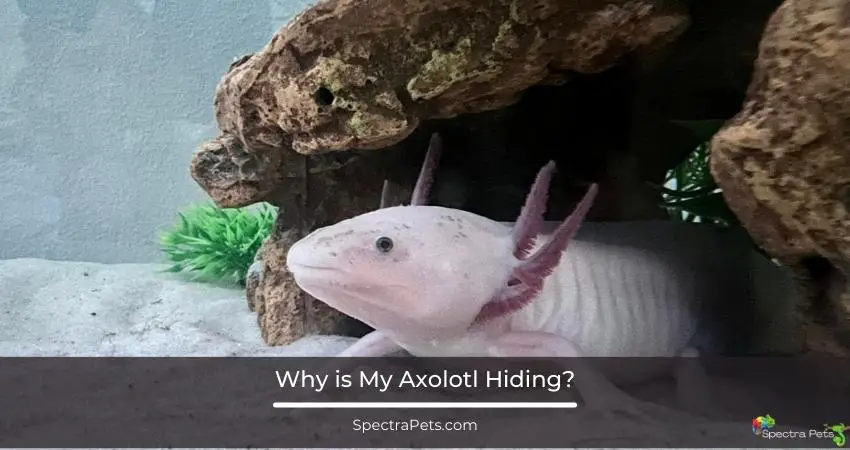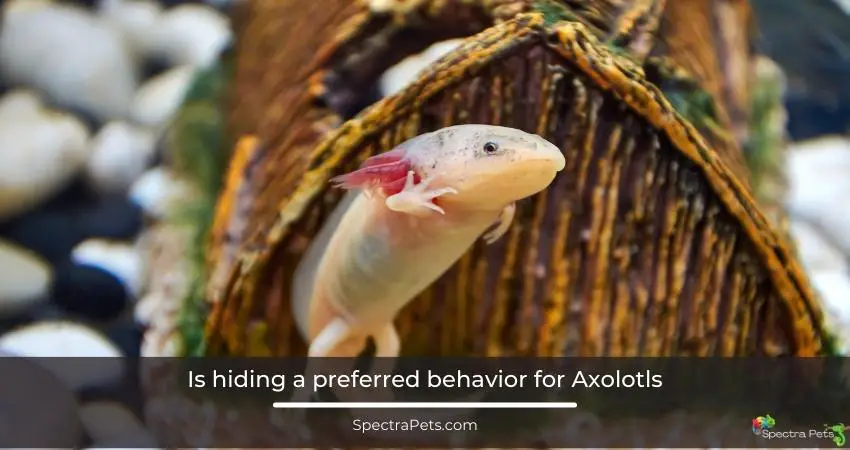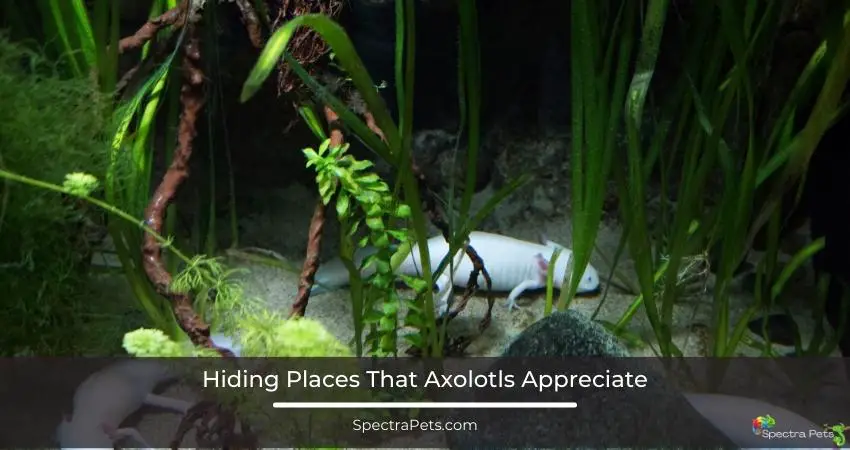Axolotls are not your typical pet. In fact, these amphibians are unique in their appearance, behavior, and habitat. Also, due to their unique looks and fascinating regenerative abilities, they have become increasingly popular among pet owners.
While not necessarily difficult to care for, these creatures do require some getting used to when it comes to their behavior and needs. One such behavior is their tendency to hide, which is a common occurrence among these captivating animals.
Now, as an axolotl keeper, it can be concerning if you notice that your pet is hiding more than usual. In this article, we will explore the reasons why your axolotl may be hiding and provide some solutions to help you address this issue.

Understanding Axolotls
Before we dive into why axolotls hide, it’s essential that we understand their behavior. Axolotls are nocturnal creatures and that’s why you will find them most active at night. However, during the day, they tend to rest and hide in their shelters. It is important to note that these amphibians do not like bright lights and are generally very shy by nature.
Moreover, Axolotls are sensitive creatures, and any environmental changes can stress them out. Therefore, it’s crucial to maintain their habitat appropriately and keep an eye on their behavior.
Read More: Axolotl Stopped Eating: what To Do?
Is hiding a preferred behavior for Axolotls?

Axolotls are known to be clumsy predators, which is an unusual trait for a carnivorous species. Their activity is higher at night while keeping their energy levels low during the day. In general, they prefer to spend most of their day time in hiding. Also, their movement during the day is slow, staying in one spot for extended periods of time, and only moving when necessary.
Although Axolotls are particularly shy, they may hide excessively if their environment is restrictive. Remember, hiding behavior is not necessarily a problem for these amphibians unless it becomes excessive, impacting their overall well-being.
Reasons Why Axolotls May Hide Excessively
Despite the fact that Axolotls are naturally shy and enjoy playing hide and seek, you should be aware of their hiding patterns. It is advisable to take this issue into consideration if you see them hiding a lot. Now let’s take a closer look at the reasons why your Axolotls may hide so frequently.
- Stress: Stress is one of the most common reasons why axolotls hide. Any change in their environment, such as changes in water temperature, water quality, can cause stress. Axolotls are also sensitive to bright light. Hence, if you don’t provide dim lighting, your cute Axies might feel stressed out and go into hiding more often. Stress can also be caused by loud noises or sudden movements.
- Illness: If your axolotl is hiding more than usual, it could be a sign that they are sick. Common illnesses in axolotls include fungal infections, bacterial infections, and parasites. If you notice any other symptoms such as loss of appetite or lethargy, you should consult a veterinarian.
- Mating behavior: During the breeding season, male axolotls may chase female axolotls, causing them to hide. This behavior is normal and should subside after mating.
- Shedding: Axolotls shed their skin frequently. During shedding, they may hide more often as they become more sensitive.
How to Help Your Axolotl
If you notice that your axolotl is hiding a lot, here are some things you can do to help:
- Check the water quality: Make sure the water temperature and quality are appropriate for your axolotl. Adjust the temperature according to your Axolotls preference. If you find the water quality is substandard, you should change the water as soon as possible.
- Provide hiding places: Your Axolotls will feel more comfortable in their aquarium if they have access to adequate hiding spots. So, make sure your axolotl has enough hiding places in their tank. You can use plants, rocks, and other decorations to create hiding places.
- Reduce stressors: Try to reduce any stressors in your axolotl’s environment, such as loud noises or sudden movements.
- Consult a veterinarian: If you suspect that your axolotl is sick, consult a veterinarian who has experience treating axolotls.
Why is my newly bought axolotl hiding suspiciously?
If your new Axolotl seems to be hiding mysteriously, don’t fret! It’s completely natural for these shy creatures to take some time to adjust to their new environment. This period of adjustment is often accompanied by a decrease in appetite, but rest assured that it’s only temporary.
To help your Axolotl settle in faster, it’s a good idea to provide plenty of hiding places within its tank. This will allow your Axolotl to feel safe and secure, and encourage it to explore its new home.
Remember, patience is key when it comes to helping your new little friend adapt to its new surroundings. Once you give your cute new buddy some time, it will soon be swimming around with confidence and ease.
What kind of hiding places does an Axolotl appreciate?

While setting up the new habitat for your axolotl, you should deliberately add some hiding spots. Here are some hiding place ideas your axolotl will admire, and you can implement these with less hassle.
- Caves or tunnels: Axolotls like to have a space where they can retreat and feel safe. Providing a cave or tunnel made from aquarium-safe materials like PVC pipes or aquarium decorations can help your axolotl feel more comfortable.
- Plants: Live or artificial plants provide a great hiding spot for axolotls. They can hide behind the leaves or weave through them, providing a natural and secure environment.
- Rocks or logs: Axolotls enjoy having objects to hide behind or under. You can place flat rocks or logs can in the tank to provide cover and create a more natural environment. However, make sure there is no sharp edge.
- Substrate: Axolotls love to bury themselves. Adding a layer of aquarium substrate to the bottom of the tank, such as sand or gravel, can give your axolotl a place to burrow and hide.
By providing a variety of hiding places, you can help your axolotl feel more comfortable and secure in its tank. Above all, you must ensure that any decorations or materials you use are safe for aquarium use and won’t harm your axolotl.
Things to consider while adding hiding places
When adding hiding spots for your axolotls, there are a few important issues to consider. I would love to discuss these things with you to ensure the safety and well-being of your axolotl:
- Size: Make sure that any hiding spot you provide is big enough for your axolotl to comfortably fit inside without getting stuck or trapped. Axolotls can grow quite large, so it’s essential to provide hiding equipment that will accommodate their size as they mature.
- Material: Avoid using any materials that may be harmful to your axolotls, such as sharp or jagged edges that could injure them or chemicals that could leach into the water. Only use materials that are safe for use in aquariums.
- Placement: Consider the placement of the hiding spots within your tank. Make sure they’re not blocking the flow of water or obstructing any filters or equipment. Also, be sure to place them in locations where your axolotls can easily access them and won’t become trapped or cornered.
- Maintenance: Hiding equipment that you place inside the tank can accumulate debris or waste over time, so it’s crucial to clean them regularly. Avoid using harsh chemicals that could harm your axolotls.
By keeping these issues in mind, it is easy to give your axolotl a safe, comfortable hiding spot.
Conclusion
Axolotls are amphibians that typically exhibit a low-energy nature and prefer to maintain a low profile. Thus, it is normal for them to spend their daytime hours in hiding. As nocturnal creatures, their activity levels are expected to rise during nighttime when the lights are turned off.
However, if your Axolotl remains inactive during nighttime, it is advisable to investigate the matter further. Such behavior is out of character for these creatures and may indicate an underlying issue that requires attention.

